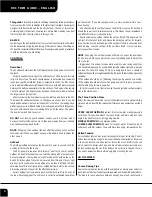
Vista Owners Manual
10/93
Section H
Page 4
9.
Drowsiness
10. Incoherence
11. Nausea
12. Dizziness
13. Fatigue
14. Vomiting
15. Collapse
16. Convulsions
NOTICE
The order of the above list is generally the se-
quence of appearance of symptoms. However,
the order of appearance may change for different
people.
NOTICE
The symptoms of Carbon monoxide poison-
ing may easily be mistaken for seasickness.
G. Treatment (Evacuate, Ventilate, Investigate, Take
Corrective Action)
1.
Move the person to fresh air.
2.
Administer oxygen if available.
3.
Contact Medical help.
4.
If the victim is not breathing, perform artificial respira-
tion per approved CPR procedures until medical help
arrives and takes over.
NOTICE
Prompt action can make the difference between
life and death.
5.
Ventilate area.
6.
Investigate source of CO and take corrective action.
H. Inspection
Look and listen for leaks in the exhaust systems of both
the generator and propulsion engine(s). Look for discol-
oration around joints in the system (water leaks, carbon,
stains, etc.).
1.
Make sure all exhaust clamps are in place and se-
cured.
2.
Make sure ventilation systems work and are not ob-
structed or restricted.
3.
Make sure gaps around the engine room plumbing
and cableways and exhaust system doors, hatches,
and access panels are minimized to reduce the op-
portunity for CO to enter the accommodation
spaces(s).
I.
Operation
Cold Start vs. Warm Start: CO production is greater
while the combustion chamber surfaces and gas pas-
sages are cold versus when they are warm. A boat op-
erator should:
1.
Pay attention to ventilating the boat,
2.
Orient the boat so it will allow the maximum dissipa-
tion of CO,
3.
Minimize the time spent on getting underway.
J.
Boathouses, Sea Walls and Other Boats
A boat operator should be aware that dangerous con-
centrations of CO can accumulate when a boat, genera-
tor or other engine operated device is operated while the
boat is moored in a confined area such as:
1.
Boathouses,
2.
Proximity to sea walls, or
3.
Proximity to other boats.
Orient the boat for maximum dissipation of the exhaust
or DO NOT run the boat or boat equipment for extended
periods under these conditions. See Figure H1.
A boat operator should be aware that carbon monoxide
is emitted from any boat’s exhaust. The operation, moor-
ing, and anchoring in an area containing other boats may
be in an atmosphere containing CO not of the operator’s
making. An operator likewise needs to be aware of the
FIGURE H1: THE EFFECT OF SEA WALLS AND
OTHER CONFINED SPACES.
Summary of Contents for 238 Vista
Page 1: ......
Page 50: ...Vista Owners Manual 10 93 Section G Page9...
Page 51: ...Vista Owners Manual 10 93 Section G Page 10...
Page 52: ...Vista Owners Manual 10 93 Section G Page 11...
Page 53: ...Vista Owners Manual 10 93 Section G Page 12...
Page 54: ...Vista Owners Manual 10 93 Section G Page 13...
Page 89: ...Vista Owners Manual 10 93 Section O Page 3 O 3 GENERAL MAINTENANCE SCHEDULE Or as Required...
Page 90: ...Vista Owners Manual 10 93 Section O Page 4 Or as Required...
Page 91: ...Vista Owners Manual 10 93 Section O Page 5 Or as Required...
Page 121: ......
Page 122: ......
Page 123: ......
Page 124: ......
Page 125: ......
Page 126: ......
Page 127: ......
Page 128: ......
















































